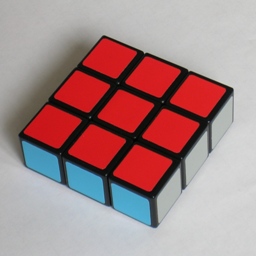
The main types of Parity are OLL and PLL Parity for NxN twisty puzzles. If you think about what the algorithm is doing, it’s actually quite simple – Uw’ R U R’ F R’ F’ R Uw.Īll this algorithm does is slice along so that the other red-blue piece is above the orange-blue piece, flips the edge, then slices back, solving both edges. Now solving this parity should be simple. If you do this to a solved cube, you can see how the algorithm affects the rest of the puzzle, but this is not noticeable during edge pairing. The flipping algorithm is as follows – R U R’ F R’ F’ R. This is used to flip an edge during edge solving (this algorithm can’t be used for OLL parity because it affects other parts of the cube that aren’t necessary to preserve during edge pairing such as corner orientation and the positions of the edges on top.
#RUBIX CUBE FLIP EDGE HOW TO#
If you know how to solve a 4x4, you will know the flipping algorithm. In the picture, the blue-red edge on the left needs to be paired with the red-blue edge on the right, and the same for the blue-orange edges. These two edges look the same, but inverted. It happens when all but two edges are solved. For even layered cubes, this isn’t technically a parity at all, but it still requires an extra “algorithm” to solve, even though it is very short and just involves using the same moves you do to solve the rest of the edges, but in a different order. Consequently, a corner has 3 colors, so its position will be between the centers that have those colors.One type of pseudo-parity is edge parity. For example, the edge that goes between the green center and the red one is the green and red edge, and being well oriented when its green color is beside the green center and the red beside the red center. To know the pieces position and orientation we focus our attention in the centers, which as we’ve said are fixed.

Our objective is to put all the pieces into their correct place, and with the correct orientation. What I mean to say is that each piece is of one type and that type can’t change (an edge will always be an edge). If we rotate one face, we see that the centers stay in the same place, while edges change to positions where there were edges, and corners change to where there were corners. In total there are 20 pieces “moveable” (12 edges and 8 corners) in the Rubik’s Cube, being all of them different from each other. There are 12 edges in the Cube, each one with two different colors. Edges: they are the pieces between the corners (in pale blue in the image).

#RUBIX CUBE FLIP EDGE DOWNLOAD#
If you want, you can also download the Rubiks Cube solutions in PDF. So, you know, solving the Rubik’s Cube is in your hands! Have you given up solving the Rubik’s Cube? Or worse, have you end up changing the stickers’ places? In this solution we’ll explain step by step all you have to do to turn your chaotic Cube into a solved one.


 0 kommentar(er)
0 kommentar(er)
